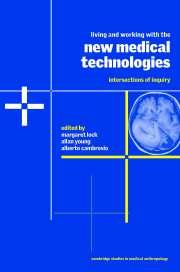Book contents
- Frontmatter
- Contents
- List of contributors
- 1 Introduction
- Part I Epochal transitions? Biomedicine and the transformation of socionature
- Part II Laboratories and clinics: the material cultures of biomedicine
- Part III Technologies and bodies: the extended networks of biomedicine
- 8 Screening the body: the pap smear and the mammogram
- 9 Extra chromosomes and blue tulips: medico-familial interpretations
- 10 When explanations rest: “good-enough” brain science and the new socio-medical disorders
- 11 On dying twice: culture, technology and the determination of death
- 12 The practice of organ transplants: networks, documents, translations
- Index
12 - The practice of organ transplants: networks, documents, translations
Published online by Cambridge University Press: 23 December 2009
- Frontmatter
- Contents
- List of contributors
- 1 Introduction
- Part I Epochal transitions? Biomedicine and the transformation of socionature
- Part II Laboratories and clinics: the material cultures of biomedicine
- Part III Technologies and bodies: the extended networks of biomedicine
- 8 Screening the body: the pap smear and the mammogram
- 9 Extra chromosomes and blue tulips: medico-familial interpretations
- 10 When explanations rest: “good-enough” brain science and the new socio-medical disorders
- 11 On dying twice: culture, technology and the determination of death
- 12 The practice of organ transplants: networks, documents, translations
- Index
Summary
In a recent paper, Margaret Lock (1995b) reviews some of the programatic literature on transplant technology and finds a subtext through which this technology is sought to be “naturalized” and thus “the contradictions that inevitably arise from mixing self and other” are disguised, though not always self-consciously. “We have been warned,” she says “about the Shiva like character of invasive biomedical technologies: potential creators of happiness but, at the same time, destroyers of society as we know it: for it is now possible to manipulate nature/culture and self/other dichotomies of long standing – projects confined thus far to the realm of fantasy” (1995b: 391).
In this chapter I try to trace the different and multiple genealogies that go in to make the object – the “transplant world” – as a set of practices. Following Foucault (1972) in his analysis of clinical discourse, I do not look for a synthesis or for the unifying function of a subject – instead, I consider the dispersions which occur over various statuses, sites and positions that can be occupied within this discourse. From its inception to its implementation, transplant technology traverses realms that are ethical, legal and medical. It forges relationships between the highly technical worlds of super speciality wards in hospitals, the worlds of organ procuring organizations and individuals; and the families within which decisions about gifting, selling, “cadaver donations” are taken.
- Type
- Chapter
- Information
- Living and Working with the New Medical TechnologiesIntersections of Inquiry, pp. 263 - 287Publisher: Cambridge University PressPrint publication year: 2000
- 39
- Cited by



